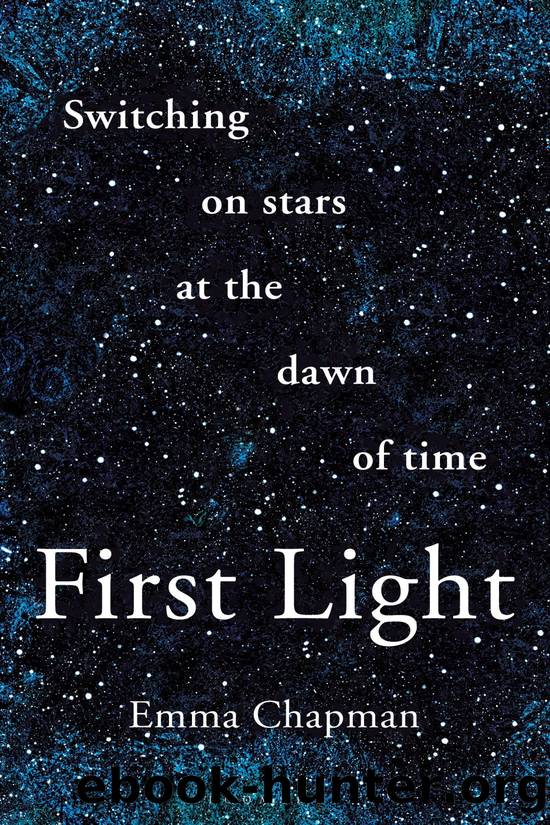First Light by Emma Chapman

Author:Emma Chapman
Language: eng
Format: epub
ISBN: 9781472962904
Publisher: Bloomsbury Publishing
Figure 19 âThe current nomenclature of stellar metallicity,4 adapted from Frebel 2018.11
The discovery of metal-poor stars
The first metal-poor stars were discovered in 1951, by American astronomer Joseph Chamberlain and his PhD supervisor Lawrence Aller,5 who measured the iron abundance in two stars and found they were about 1/10th the solar value.13 This may seem a small difference from our Sun, but at the time it was revolutionary, and Chamberlain struck gold in the academic sense, too, as this was his first ever paper and it turned out to be one the most important astronomical papers of the twentieth century. Until that point it had been assumed that all stars had roughly the same elemental make-up as the Sun. Stars with different strengths of metal lines had been observed, but this was explained away by the stars being of different spectral type only, and not indicative of a different generation entirely. Spectra were, after all, the tool that was used to separate out the stellar zoo into the OBAFGKM classification system in the first place, with the strength of the hydrogen lines becoming a proxy for temperature. In Chamberlain and Allerâs paper you can feel their disbelief as they reveal their results, book-ended with phrases such as âthe observed [iron] abundance appears to be smaller than in the sun, although this conclusion must be taken with cautionâ. They refer to the measured iron abundances as âthe one undesirable factor in our interpretationâ. Another case, then, of the undesirable noise becoming the paradigm-shattering signal, though with less pigeon poo this time.
Itâs easy to look back in hindsight and cherry-pick these kinds of statements from the unassuming papers that changed our world view, but what we are looking at are good scientists. They had a sample size of two metal-poor stars against the accepted knowledge that stars were all the same, all like our Sun, and while a scientist should be confident in their analysis to publish, rarely does a eureka moment come so clearly. More often, instead of âEureka! Iâve got it!â, it is âThat looks weird! Hang on, what is that? I think that might be ⦠huh. Hey, can you all check this to make sure I havenât done something stupid?â It often requires a few eureka moments for people to be comfortable leaving their comfy, but wrong, theories. When you read backwards from Chamberlain and Allerâs work you see hints that the ground was already shifting under the homogenous star theory, for example in their reference to American astronomer Nancy Romanâs work the year before. Nancy Roman had a major role in planning the Hubble Space Telescope and was the first woman in an executive position at the National Aeronautics and Space Administration (NASA), but before all that her work provided a hint that stars were not all the same. What she did was take a sample of stars and categorise them firstly by how weak their metal lines were, and secondly by their velocities.14 As far back as
Download
This site does not store any files on its server. We only index and link to content provided by other sites. Please contact the content providers to delete copyright contents if any and email us, we'll remove relevant links or contents immediately.
The Switch by Beth O'Leary(1080)
Sisters by Daisy Johnson(1072)
Guard Duty by Sharon Dunn(859)
The Enemy by Sarah Adams(858)
Explosive Situation by Terri Reed(738)
The Christmas Killer by Alex Pine(737)
Alaskan Showdown by Sarah Varland(731)
The Ruthless Billionaire by Evangeline Kelly(691)
The Chronicles of Narnia -Complete Series- by C. S. Lewis(683)
Dangerous Women by Hope Adams(642)
Fans Only by B. Love(611)
The Heart's Song by Winnie Griggs(594)
Valley of Shadows by Shirlee McCoy(591)
TRUTH by James Crow(540)
Nine by Rachelle Dekker(535)
World's End by Ed James(521)
Truth of the Divine by Lindsay Ellis(506)
Kill Order by Adam Blumer(475)
Forget Me Not by Sarah M. Eden(473)
